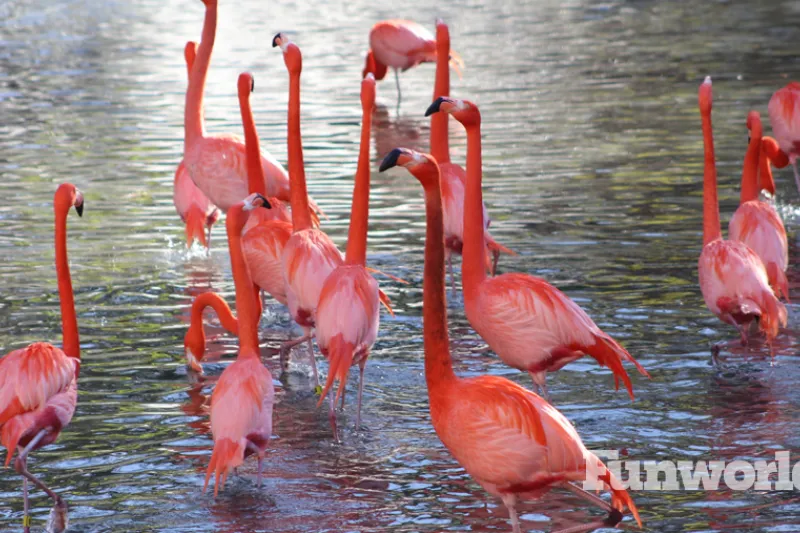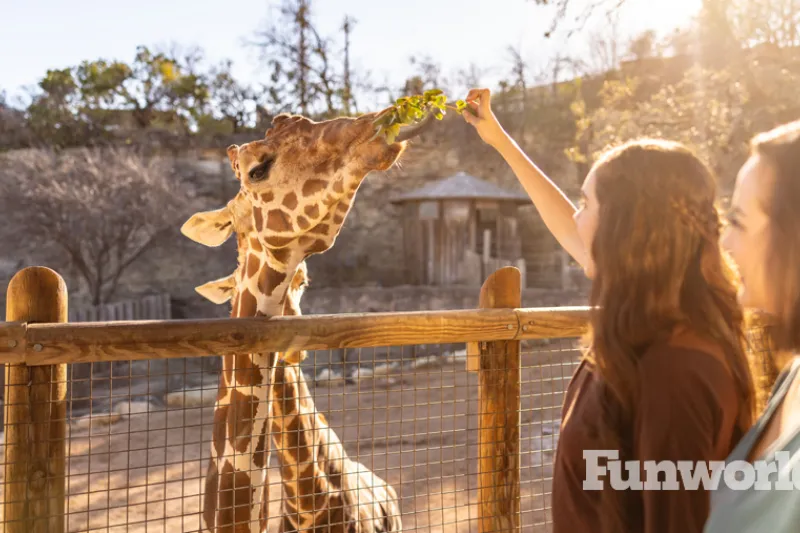Tour button
Innovation Takes Flight at San Antonio Zoo
How this historic institution prepares for the future

Driving through the sprawling 349-acre Brackenridge Park, located just north of downtown San Antonio, visitors find themselves in an idyllic scene of sprawling meadows, winding trails, picnicking families under mature oaks, Japanese tea gardens, century-old stone buildings, and ducks gliding across tranquil waters. As the road winds through the north end of the property, traffic stops to let a miniature train cross the road before it heads into the city park’s expansive landscape.
Here, The San Antonio Zoo awaits. Upon arrival, a towering new entrance gate—added in December of 2023—welcomes guests and serves as one of the latest and most visible upgrades to the 111-year-old facility. The previous entrance gate, added in the 1950s, was replaced with one that sets a better tone for the beginning of the guest experience, in addition to a host of benefits that enhance accessibility, inclusivity, and the overall visitor experience that The San Antonio Zoo is proud to share with Funworld.

A Legacy of Innovation
While habitats at zoos, aquariums, and museums are becoming increasingly interactive, the San Antonio Zoo traces its first cageless habitats back to 1929— the first instances of United States zoo visitors seeing animals outside of crates. Many of the zoo’s habitats are connected by a moat system that allows the animals to be visible without bars or cages, in their habitat, as visible as possible to guests. “We were blessed that we are built in an old rock quarry, so we have all this beautiful limestone to create these habitats, more natural like it is in the wild,” says vice president of marketing, sales, and communication, Hope Roth. The zoo’s habitats are also designed with conservation and education in mind.
In October 2024, the zoo opened its new Naylor Savanna, the expanded home of the facility’s giraffes, zebras, ostriches, sitatunga, and more species of African wildlife in a sprawling, naturalistic habitat that allows the animals to roam freely while guests can enjoy up-close encounters and interactive opportunities. The Naylor Savanna doubles the habitat’s previous space and includes a new, state of the art giraffe barn that allows the zoo to participate in the Species Survival Plan’s (SSP) Giraffe Breeding Program within the Association of Zoos and Aquariums (AZA). The new giraffe barn includes individual giraffe rooms, a large family room, and a VIP encounter space for guests.
A key component of the Naylor Savanna is the Spekboom Lodge—a luxury suite that provides guests the opportunity to sleep overnight at the zoo, close to the animals. The Spekboom Lodge opened in November 2024 with room for up to four guests. Included is a primary bedroom with a king bed, a living area with two twin beds, an outdoor patio, and a kitchenette. Included in a stay at the lodge is exclusive zoo access up to two hours after closing and an hour before opening, and complimentary access to zoo animal interactions and encounters. Always keeping conservation in mind, the zoo donates a portion of lodge revenue to the Giraffe Conservation Foundation (GCF), the only global organization dedicated to ensuring the survival of giraffes.

Rooted in Education and Conservation
With all the new improvements, upgrades, and innovations coming, the zoo understands the importance of keeping hallmark features as constants. Visitors will notice botanical gardens, grand shade trees, and historic structures all throughout the facility, many constructed of stone. One such structure is what serves as the unofficial backdrop to the new entrance plaza—the zoo’s historic monkey house. The ornate stone structure with a Spanish tile roof dates to the mid-1930s and was listed on the National Register of Historic Places in 2024.
The San Antonio Zoo is more than an attraction—it’s fulfilling an educational mission. At the forefront is the Will Smith Zoo School, the largest nature-based preschool in the nation. With 240 students from more than 60 zip codes, this innovative program immerses children in outdoor learning 70% of the time, regardless of weather. Unlike a typical field trip, these children are on-site daily, developing a deep connection to nature and conservation. Scholarships for tuition assistance ensure accessibility, and the school’s mission is clear: inspire the next generation of conservationists through unmatched education.
The zoo’s commitment to conservation extends far beyond its gates. Proceeds from every ticket sale directly supports wildlife conservation projects across six continents, from saving Texas horned lizards to protecting rhinos, jaguars, and giraffes. The zoo also plays a critical role in rehabilitating rescued and endangered animals, working closely with the U.S. Fish and Wildlife Service to provide care for animals confiscated from illegal pet trades. Some species that are virtually extinct in the wild have a home here where staff breed and grow the population for eventual release back into their natural habitats.
At home in San Antonio, where the state reptile, the Texas Horned Lizard has been at risk, the zoo leads conservation efforts that focus on habitat restoration, breeding, and reintroduction back into the wild, restoring populations in cooperation with local landowners. “We’ve had five reintroductions into the wild,” says Roth.
Already announced for a late 2025 opening is what is to be one of the largest gorilla habitats in the nation—Congo Falls. Breaking a 30 year absence of gorillas at the San Antonio Zoo, the habitat will open with a bachelor troop of four silverbacks that will live together, and a family group of one silverback and three females that are all part of the SSP. “That is so exciting because it’s unheard of and that really speaks volumes to the habitat that’s been created,” says Roth.
Another announced feature of this new exhibit is a more than 60 foot tower that gorillas will be able to climb in guest view, serving as a jungle gym. Roth tells Funworld the tower with climbing gorillas will be visible to freeway motorists outside the zoo while guests inside will enjoy 360 degree views at ground level, via a walkway netted in the air that allows guests the ability to walk above the habitat, and from The Ralston which is a 500 guest capacity event center that will overlook the new Congo Falls and Naylor Savanna, along with unobstructed views of the San Antonio skyline. The Ralston event center was made possible by a donation from the Ralston Family Foundation’s $10 million donation—the zoo’s largest single donation from a single individual.

Getting Creative and Driving Revenue
While the zoo operates a two-mile long miniature railway attraction that sits just outside of the perimeter of the zoo and meanders through Brackenridge Park, a full-sized carousel with a menagerie of unique animal figures from Chance Rides operates inside the zoo. The facility also owns and operates the historic Kiddie Park attraction, which is another hallmark of the area since 1925. In 2019, the zoo acquired the amusement park’s dozen vintage rides and moved them to a spot near the zoo’s front gate. When former ownership of Kiddie Park was looking to close, the zoo saw this as an opportunity to preserve the oldest children’s park in the United States and harness yet another viable offering for the larger complex that increasingly looks to diversify its offerings.

Follow IAAPA for news and event announcements in your favorite social media apps
Connect with the Real Stories Behind the Fun
Follow our social media for authentic stories, special moments, and behind-the-scenes looks from the attractions world.












 The Official Magazine of IAAPA
The Official Magazine of IAAPA